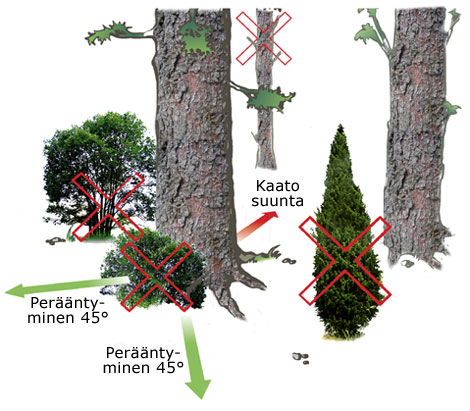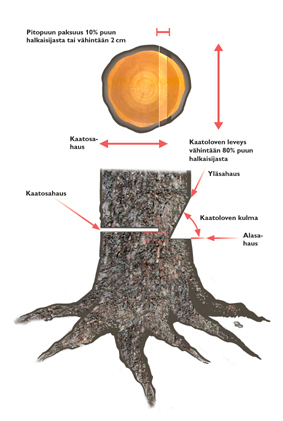Before starting the felling
Before starting the felling, you should find out if you have to follow any nature conservation regulations in the area.
- Make sure there are no roads, power lines or buildings near. If there are, let an experienced logger do the job.
- Remember to put warning signs around the area, if there are people moving near daily.
- Make sure there is nobody at felling distance. The safety distance has to be two times the length of the tree to be felled.
Planning the felling
Before felling a tree, the following matters have to be taken into account:
- Inclination of the tree
- The direction of the wind
- Where is it best to fell the tree considering further work stages
It is advisable to clear the surroundings from other vegetation. There has to be room for stepping aside when the tree fells. The lower part of the trunk should also be delimbed.
Directed felling
- First, the wedge cut is sawn. It defines the felling direction of the tree.
- Disturbing roots are removed from the base of the tree.
- An oblique upper saw cut is made on the trunk with an angle of about 60º.
- Sawing is continued until 20-25% of the diameter is sawn.
- Next, a horizontal lower saw cut is made so that it meets the upper sawing.
- A horizontal felling saw cut is made above the lower sawing.
- The sawing should be ended before meeting the saw cut, so that a hinge of 2 cm at the minimum remains.
- The hinge functions as a hinge and directs the felling direction of the tree.
Felling devices
Devices can prevent the tree from falling into a wrong direction and the saw blade from getting stuck during sawing.
- Felling lever is suitable for felling thin trees.
- It is best to use a felling wedge in felling thick trees.
When felling thick trees, a bit more complicated felling technique is used. The idea is the same, but the saw cut is completed from the other side, because the saw blade of a chain saw does not reach through the trunk.
If a tree is defected by rot, you should be extremely careful. Rot defected wood is different in colour and feels soft, unlike healthy wood. You have to leave a thicker hinge when felling a tree defected by rot. This way the tree can be felled safely.
